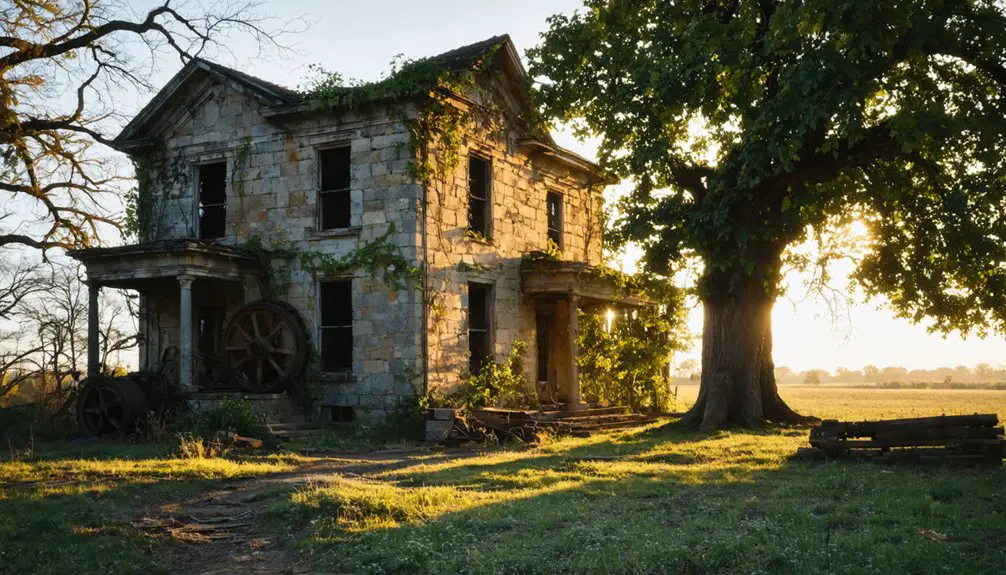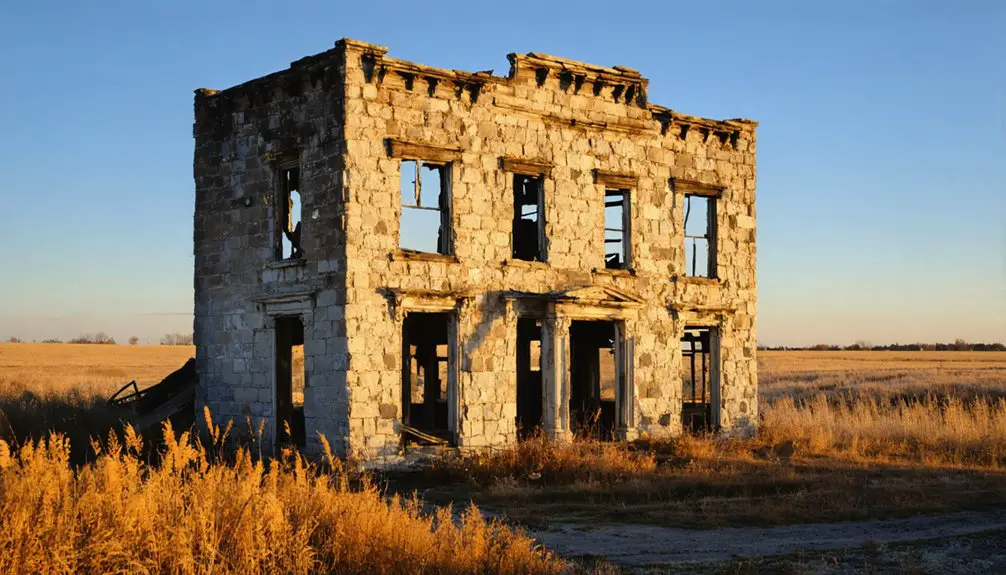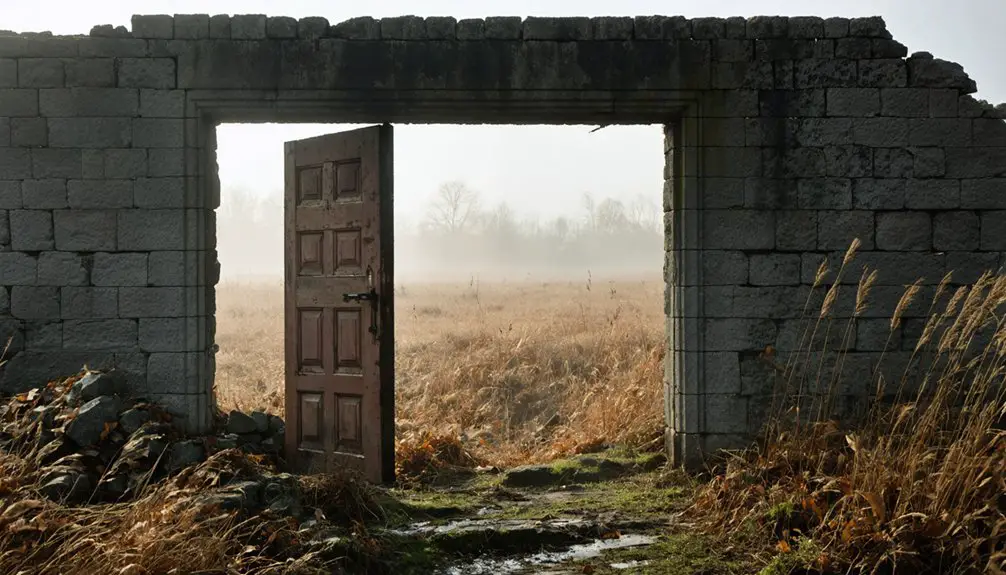You’ll find Silkville’s fascinating ruins near Williamsburg, Kansas, where French socialist Ernest de Boissière established a utopian commune in 1869. He built a grand 60-room chateau and recruited French families to create a silk-producing community spanning 3,500 acres. For 23 years, the settlement thrived with silk production, dairy operations, and communal living before its decline in 1892. Today, limestone structures and barn ruins stand as silent witnesses to this ambitious socialist experiment.
Key Takeaways
- Silkville was established in 1869 by Ernest Valeton de Boissière as a socialist commune focused on silk production near Williamsburg, Kansas.
- The settlement featured a 60-room limestone chateau, which burned down in 1916, though its rebuilt main house still stands today.
- Two historic limestone barns, a schoolhouse, and remnants of stone fencing survive as visible ruins of the former commune.
- The commune operated for 23 years before collapsing in 1892, marking the end of this utopian socialist experiment.
- Traces of the original mulberry groves and building foundations remain visible at the abandoned settlement site.
The Vision of Ernest De Boissière’s Utopian Dream
When Ernest Valeton de Boissière fled France in the aftermath of Napoleon III’s 1851 coup d’état, he carried with him a revolutionary vision shaped by Charles Fourier’s utopian socialist philosophy. His dream would later materialize in Kansas as Silkville, a bold experiment in communal living and shared prosperity.
Seeking refuge from political upheaval, de Boissière brought Fourier’s utopian dream to Kansas, establishing a socialist commune called Silkville.
You’ll find that de Boissière’s vision aligned perfectly with Fourierist philosophy, emphasizing universal sharing and cooperative labor. Members would pay one hundred dollars to become part of this idealistic venture.
In 1869, he purchased 3,500 acres near Williamsburg, Kansas, for about $3 per acre. He recruited forty French families to join his commune, building a 60-room chateau as their shared home.
The community would work together, sharing in silk production, farming, and various manufacturing ventures. It wasn’t just about profit – it was about creating a society where everyone cared for one another. By 1871, the community had established an impressive 8,000 mulberry trees to support their silk production efforts.
Silk Production and Agricultural Endeavors
Once silk production began in 1870, Silkville’s ambitious enterprise took shape with silkworm eggs sourced from California. By 1872, French weavers operated three looms, producing up to 300 yards of silk daily.
Despite achieving silk quality equal to Italy’s finest, the operation faced significant hurdles when American dyes proved inadequate, forcing costly shipments to France for processing. Charles Sears managed the property operations during this challenging period.
To combat mounting financial pressures from global competition, Boissière launched bold agricultural innovation initiatives. You’d have found extensive dairy operations producing 1,200 pounds of cheese and butter daily, alongside orchards, vineyards, and livestock farming. The community planted 8,000 mulberry trees to sustain their silk production efforts.
While these diversification efforts earned accolades, including prizes at the 1876 Centennial Exposition and World’s Fair, they couldn’t overcome fundamental challenges. Members preferred private ownership to communal farming, and upfront cash demands from milk suppliers strained the cooperative model.
Life in the 60-Room Chateau
Inside the massive 60-room chateau, you’d find French and Swedish immigrants sharing meals in a large communal dining room while maintaining separate living quarters organized by nationality.
The three-story limestone structure could house up to 100 workers, with simple apartments and dormitory-style rooms arranged to maximize cooperation and productivity. The residents enjoyed singing and dancing together during their leisure time.
Your daily life would revolve around structured routines and communal activities, from shared meals to work planning sessions, all coordinated within the chateau’s central gathering spaces.
Communal Dining and Entertainment
At the heart of Silkville’s social structure stood the commune’s 60-room chateau, where residents gathered daily in a common dining room that operated like a restaurant. These communal meals fostered social interaction and reinforced the community’s utopian ideals while still respecting individual choice – you could live privately if you preferred.
Beyond dining, you’d find the chateau bustling with entertainment and cultural activities. The spacious building hosted informal music sessions, storytelling circles, and group discussions.
These shared experiences strengthened community bonds while educational programs in the on-site school enriched daily life. The chateau’s multifunctional spaces served as natural hubs for communication and decision-making, creating an environment where collective well-being and individual freedom could flourish together under one roof.
Living Quarters and Layout
The three-story chateau‘s design reflected both grandeur and practicality, accommodating up to 100 residents across its 60 rooms. You’d find 40 families sharing this impressive structure, built by Ernest V. Boissiere in the 1870s.
The room configurations supported a communal lifestyle, with shared dining rooms and a spacious library that brought residents together. The residents produced silk and cheese alongside their daily activities. As a flag stop location, the chateau’s proximity to the Santa Fe Railroad provided convenient transportation for residents and goods.
The chateau stood as an architectural marvel for its time until tragedy struck in 1916 when fire consumed most of the building. Following the destruction, survivors rebuilt a smaller house using the west end of the original structure.
Today, while you can’t explore the original chateau’s communal spaces, you’ll still find remnants of this once-thriving community, including limestone fences that marked the property boundaries.
Daily Routines and Rules
Life within Silkville’s grand chateau followed a carefully structured routine that balanced work, education, and communal living.
You’d start your day by heading to the communal dining room, where you’d share meals with up to 100 fellow residents. Your work schedule revolved around silk production, farming, or other essential tasks like dairy operations and blacksmithing, with your wages tied directly to your output.
Daily education was a priority, especially for children who attended the stone schoolhouse. You’d have access to Kansas’s largest library, housing 2,500 books, and could participate in intellectual discussions in the chateau’s luxurious parlors.
While you’d maintain your private family apartment, you’d share communal responsibilities and adhere to collective rules, paying a $100 membership fee to be part of this self-sustained community.
The Rise and Fall of a Socialist Experiment

You’ll find the story of Silkville’s rise and fall reflected in its ambitious silk production facility, which by 1872 could produce 224 yards of ribbon daily but struggled to achieve lasting prosperity.
Located in Franklin County, Kansas, this experimental socialist community was founded by Ernest de Boissiere with high hopes for creating an alternative social model.
The community’s socialist vision of shared work and proportional pay faced mounting challenges as suppliers demanded cash payments and new settlers proved difficult to attract to the isolated Kansas prairie.
While the farm operations remained profitable even after the socialist experiment ended, Boissiere’s death in the 1890s marked the final chapter of this unique attempt to establish a Fourierist utopia in America’s heartland.
Silk Dreams Meet Reality
Inspired by Charles Fourier’s utopian socialist philosophy, French aristocrat Ernest Valeton de Boissiere established Silkville in 1869 after fleeing political turmoil in France. Purchasing over 3,000 acres near Williamsburg, Kansas, he envisioned a self-sufficient commune centered around silk cultivation.
You would have seen 70 acres of mulberry trees feeding silkworms and a large stone building housing productive looms. By 1872, workers produced 224 yards of silk ribbon daily. The community expanded into dairy production, churning out 1,200 pounds of cheese and butter per day by the 1880s.
Despite these achievements, communal challenges emerged. The $100 entry deposit and strict productivity requirements couldn’t prevent internal tensions.
Payment disputes with local farmers and conflicts between socialist ideals and family farming ultimately led to the experiment’s decline.
Economic Vision Goes Bust
The economic vision of Silkville began with considerable promise and substantial investment. You’d find de Boissiere’s initial purchase of 3,156 acres for $11,450 represented a significant commitment to his Fourierist ideals.
The community’s economic foundation rested on silk production and dairy operations, with workers required to make a $100 deposit to join.
Despite producing extensive silk ribbons and achieving impressive dairy output of 1,200 pounds daily by the early 1880s, Silkville faced mounting economic challenges.
The financial sustainability of the socialist experiment proved elusive. You’ll see how conflicts over milk payments and the struggle to maintain their frugal lifestyle model eventually led to the community’s downfall.
Utopian Ideals Fade Away
While de Boissiere’s vision of a Fourierist utopia initially drew sympathetic followers to Kansas in 1869, the socialist experiment at Silkville gradually unraveled over two decades.
You’d have witnessed mounting communal conflict as the reality of economic disparity set in. Despite the 60-room chateau’s promise of collective harmony, residents began drifting away from the commune’s founding principles.
The silk production that once symbolized their shared purpose couldn’t compete with established global markets, and attempts at diversifying into cattle and cheese-making failed to sustain the community.
By 1892, the dream of cooperative living had collapsed entirely. When flames consumed the grand chateau, they took with them the last physical remnants of de Boissiere’s utopian vision.
He returned to France, leaving behind only scattered buildings as evidence to Silkville’s ambitious socialist experiment.
Architectural Legacy and Remaining Structures

Standing as remnants of a once-thriving utopian settlement, Silkville‘s architectural legacy includes several limestone structures that have endured since the 1870s.
You’ll find the main house, rebuilt after the original three-story chateau burned in 1916, retaining some of the west end’s original stone walls.
Two historic barns showcase the settlement’s architectural significance – one previously served as a cocoonery until a tornado claimed its upper floor, while the other maintains its rectangular form beneath a modern metal roof.
The property’s structural preservation extends to a limestone schoolhouse at the north corner and remnants of a four-foot stone fence that once encircled the 3,500-acre property.
You can still spot foundations of other buildings and traces of mulberry groves that supported Silkville’s silk-making venture.
Silkville’s Place in American Utopian History
Beyond the weathered limestone walls lies a remarkable chapter in American utopian history. In 1869, French aristocrat Ernest Valeton de Boissiere established Silkville as a symbol of Fourierist principles, creating one of America’s most enduring experiments in communal economics.
You’ll find Silkville’s significance in its 23-year run, outlasting many similar ventures of its era. De Boissiere’s vision combined practical industry with social idealism, requiring members to contribute financially while sharing in the community’s prosperity.
Unlike purely ideological communes, Silkville balanced agricultural production with silk manufacturing, positioning itself as a working model of cooperative living.
The community’s blend of French émigré families and American workers demonstrated how Fourier’s theories could be adapted to the post-Civil War Midwest, even as market pressures ultimately proved insurmountable.
Frequently Asked Questions
What Happened to Ernest De Boissière After Silkville’s Decline?
You’ll find that Ernest’s legacy ended quietly as he transferred Silkville to the Odd Fellows. De Boissière’s ventures concluded there, with no records showing his return to France or other projects.
Did Any Descendants of Original Silkville Residents Still Live in Kansas?
You won’t find confirmed descendant stories of original Silkville residents in Kansas today. While family legacies were shared through writings like Janelle Richardson’s blog, there’s no documented evidence of local descendants remaining.
How Much Did Silk Workers Earn During Silkville’s Peak Production Years?
Like threads woven into mystery, you won’t find exact silk wages recorded – workers didn’t earn traditional pay but shared communal resources, housing, and farm goods under Silkville’s unique labor conditions.
Were There Any Notable Conflicts Between Silkville Residents and Neighboring Communities?
You won’t find evidence of major Silkville conflicts with neighbors. Historical records show the community’s troubles were internal, focusing on property disputes and economic challenges rather than neighboring tensions.
What Specific Silk Products Were Manufactured and Where Were They Sold?
You’d find ribbons, velvet trimmings, and broad silk fabrics manufactured through silk production at the stone factory. They’d sell these products locally, at fairs in Kansas, and display them at Philadelphia’s 1876 Centennial Exhibition.
References
- https://en.wikipedia.org/wiki/Silkville
- https://www.franklincokshistory.org/wp-content/uploads/2011/07/History-of-Silkville.pdf
- https://footprints.com/blogs/take-a-walk-with-birkenstock/silkville-kansas
- https://kids.kiddle.co/Silkville
- http://explorekansas.blogspot.com/2014/06/silkville-day-they-came-to-dance.html
- https://oztripper.wordpress.com/2012/12/24/silkville-kansas-2/
- https://legendsofkansas.com/silkville-kansas/
- https://dspacep01.emporia.edu/bitstream/handle/123456789/456/41.pdf?sequence=1
- https://lostkansas.ccrsdigitalprojects.com/sites/lostkansas/files/private_static/2022-12/LT_FR_Silkville_Angermayer.pdf
- https://abandonedkansas.wordpress.com/category/silkville/



